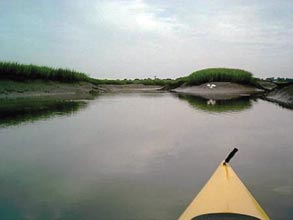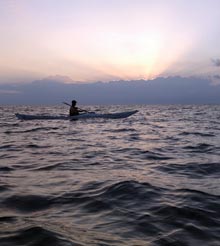 By Kim Gundler
By Kim Gundler
Breathe in. Breathe out. Now more slowly. Now really slowly; your incoming breath stretching out to a 6-hour inhale, followed by a 6-hour exhalation. This twice a day breath is the rising and falling of the tides into and out of our salt marsh, creating one of the most productive and beautiful landscapes in the world.
Our salt marsh is one of the defining landmarks of Beaufort, which is apt, considering we have fully half of the salt marsh contained in the entire state of SC. When returning from a trip away, we know we are home as soon as we cross the Whale Branch bridge and see that grand expanse of water and grass stretched out in both directions. If we’ve been gone a long time, no matter what the weather, we’ll roll down all the windows and breathe deeply of that lusty fragrance. In The Prince of Tides, Pat Conroy described the smell of the salt marsh as, “a smell like new milk, semen and spilled wine, all perfumed with seawater.”
While kayaking, we get to spend quite a bit of time in the salt marsh, and experience this “long breathe” almost every day. Riding the tidal current up into a small salt marsh creek bed just filling after low tide, we experience the reawakening of the plants and animals that have been waiting for the life-giving waters to return. Oysters begin opening their shells to take a breathe for the first time in hours. Clams extend their siphons, worms rise from their decorated tubes, and small planktonic plants and animals repopulate the once-dry creek bed. As the water deepens, an audience of fish, crabs, wading birds and dolphins join the inward procession.
During this extended “inhale”, the Spartina grass and salt marsh algae are busy getting dinner on the table. Using the returning water and abundant sunshine found in these wide-open spaces, the plants are producing food for the hungry consumers coming up the creek. These plants have a tough job; living in salt water is difficult, and they will use 77% of the total energy they create just to expel salt from their cells. Yet even with this handicap, the combined production of the Spartina grass and algae in the marsh has been measured at nearly 20 tons of biomass per acre annually, making the salt marsh one of the most productive ecosystems in the world.
As the marsh “exhales,” and the tide begins to fall, much of this intense productivity leaves the  marsh as detritus, a kind of nutritious stew, flowing down from the upper reaches and small creeks to larger bodies of water, like the Port Royal Sound. This water carries a gigantic load of nutrients that will be taken up by the zooplankton, invertebrates, fishes and mammals of the sound and the Atlantic Ocean.
marsh as detritus, a kind of nutritious stew, flowing down from the upper reaches and small creeks to larger bodies of water, like the Port Royal Sound. This water carries a gigantic load of nutrients that will be taken up by the zooplankton, invertebrates, fishes and mammals of the sound and the Atlantic Ocean.
This is just a peek at the diverse amount of activity happening in our salt marshes every day. Hopefully it will pique your interest to get out there. Watch a fiddler crab emerge from it’s burrow after a falling tide. Hear the “pop” of snapping shrimp stunning prey with their pistol-like claw. Taste the salt water. Feel the breeze. Smell the marsh. Breathe in. Breathe out.
Kim Gundler is co-owner/operator of Beaufort Kayak Tours along with her husband David. They lead interpretive kayak tours on the waters of Beaufort County. www.beaufortkayaktours.com 843.525.0810







